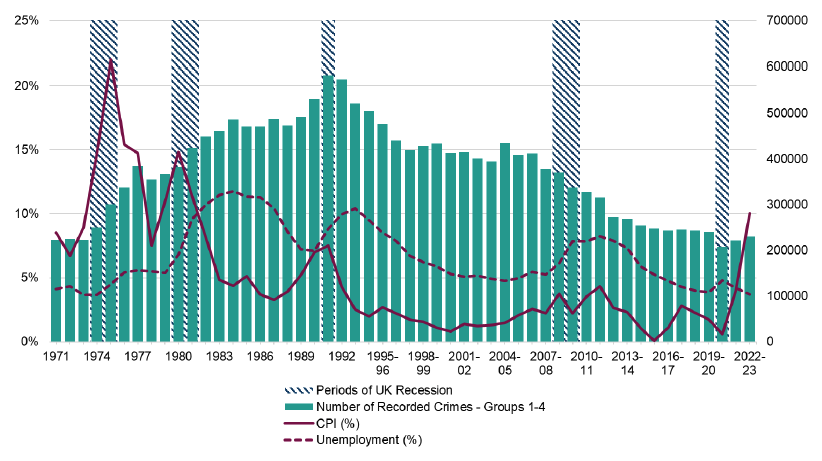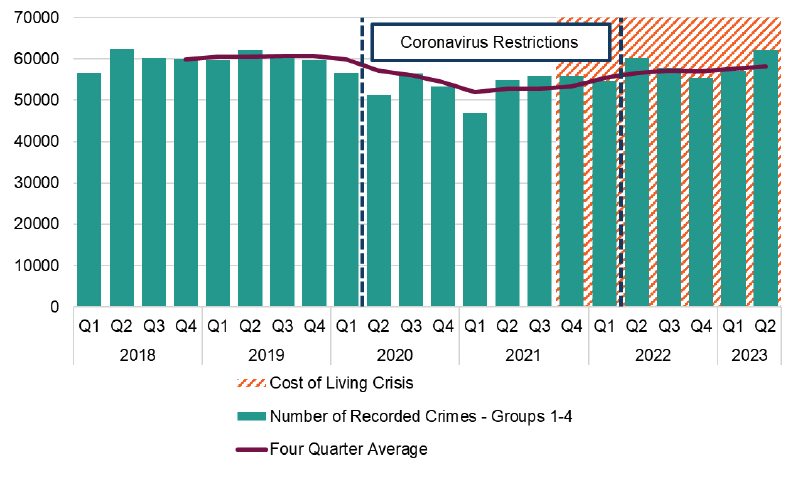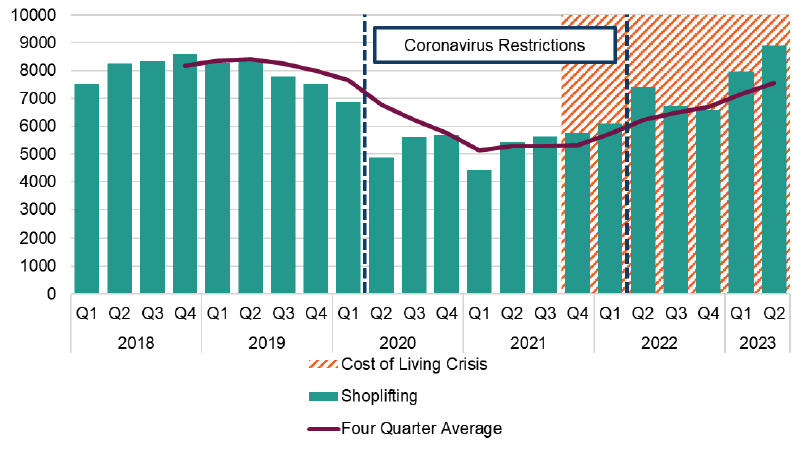Cost crisis and crime in Scotland
Within the context of the ongoing cost crisis, this occasional paper explores the relationship between macroeconomic performance and crime in Scotland.
Part Two: Ongoing Monitoring
Part Two sets out the findings from our monitoring of the most recently published Police Recorded Crime data. This section is informed by the key findings from the literature review outlined in Part One and begins by looking at overall recorded crime and then focuses specifically on recorded crime data for crimes against property, including acquisitive crime types.
Our approach to monitoring this data source had two key stages: monitoring of overall recorded crime and monitoring of specific crime groups and crime types. The existing evidence on the relationship between economic downturns and overall crime rates is ambiguous and inconclusive. To determine whether this remained the case for the current cost crisis we mapped the most recent overall police recorded crime figures against the current cost crisis period, which is characterised by high levels of inflation, relatively low levels of unemployment and significant decreases in real term pay. Our second stage of monitoring was more granular; we focused on the top 50 crime types[64] and mapped these against the cost crisis period to identify and monitor specific crime types, including those flagged within the existing evidence review.
It is important to acknowledge that no single source of data or evidence will capture a complete picture of crime, nor is one source definitive on a given crime type. For example, police recorded crime data are detailed and of good quality, but omit unreported crime. By contrast, victimisation surveys capture some unreported crime, but only provide estimates on the limited topics and circumstances covered by the survey. A further important distinction between the two data sources is the types of crimes they cover, the SCJS captures crimes where there is a victim that can be interviewed including, for example, violence and housebreaking, not homicide or shoplifting. Whereas police recorded crime captures all crimes reported to the police, including those committed against businesses like shoplifting. Therefore if, for example, there was to be a rise in shoplifting this would be identified by police recorded crime (under the assumption these crimes were reported) but it would not be picked up by the SCJS. Despite the differences in these data sources, however, they have shown very similar trends when viewed over the longer term.
In the next occasional paper we will draw heavily on the most recent publication of the Scottish Crime and Justice Survey as well as the most recent quarterly police recorded crime data. Where possible we will also draw upon a wide range of additional sources including, but not limited to, homicide and NHS hospital admissions data in relation to violent crime. By monitoring a wide range of sources we mitigate the weaknesses associated with an overreliance on any single source of evidence or data.
Overall Recorded Crime
The review of the existing evidence established that there is no certain link between economic performance and overall crime and analysis of the latest Police Recorded Crime data supports this conclusion.
Although omitting crimes which are not reported to the police, recorded crime provides accurate and reasonably consistent records over decades[65]. Overall recorded crime rose steadily from the 1970s to the early 1990s. Since then, crime has gradually fallen[66]. The 2008 recession is the most recent period of economic downturn prior to the current cost crisis. Whilst it may be intuitive to assume that crime increased over the 2008 recession, according to police recorded crime[67] and the nationally representative victimisation surveys in the United Kingdom[68], overall crime fell throughout this period and continues to fall to the present day. The Scottish Crime and Justice Survey 2019/20[69], which includes crimes not reported to the police, reports that the volume of crime in Scotland has fallen by 46% since 2008/09.

Figure 7 takes a closer look at overall recorded crime over the past five years:

We can see that recorded crime fell over the course of the pandemic and can be seen to have risen following the pandemic and during the cost of living crisis. However, it has not yet risen to pre-pandemic levels as of the second quarter of 2023, with the latest four quarters' worth of crime data for Groups 1-4 sitting 4% below the equivalent position for year ending June 2019. As such, the relationship between total recorded crime and the cost of living crisis remains unclear and we are unable to determine whether the recent, slight rise in the recorded crime figures, as a whole, are as a result of the crisis or, simply as a result of the removal of coronavirus restrictions and a return to 'normal' life. This ambiguity is reflective of the finding, outlined in the 2010 Scottish Government paper, that the existing evidence is "by no means conclusive in favour of a particular theory or certain economic variable having a relationship with overall crime." Looking at the Crime Survey for England and Wales, that reports on all crimes in England and Wales including those not reported to police, we find that for overall crime there has been a decrease of 15% in the year ending March 2023 when compared with the pre-coronavirus pandemic year ending March 2020. This finding suggests that England and Wales, like Scotland, has not seen a return to pre-pandemic levels of overall recorded crime.
However, it is perhaps reductive to discuss the relationship between economic performance and overall recorded crime as we know from the academic evidence review that certain crime types are more likely to be impacted by changes in economic conditions. The following sections explore individual crime types that, based on existing data and evidence, appear like they may have been impacted by the cost crisis.
Crimes of Dishonesty
Figure 8 depicts the trend for Group 3 crime types, 'Crime of Dishonesty' in Scotland over the past 5 years. This group is the largest crime group and accounts for just over a third (36%) of all crime recorded in Scotland in 2022-23. In descending order of volume, the group includes, amongst other crimes, theft, shoplifting, fraud, housebreaking and theft of a motor vehicle.

We see here that there has been a rise in these crime types since the beginning of the cost of living crisis and that the latest police recorded crime data, relating to Quarter 2 of 2023, appears to confirm this trend. However, it is important to note that numbers of this crime type have not yet returned to pre-pandemic levels and as such it is unclear whether we are witnessing the effect of the cost crisis or simply a return to pre-pandemic rates for this crime type. Continued monitoring over the coming quarters will determine whether the number of Crimes of Dishonesty settles at pre-pandemic levels or surpasses them.
Shoplifting & Theft of a Motor Vehicle
If we take a closer look at two specific crime types, shoplifting (Figure 9) and theft of a motor vehicle (Figure 10) then we see again this trend of crime increasing over the cost of living crisis:

Shoplifting accounted for over a quarter (28%) of Crimes of Dishonesty. There was an increasing trend since 2014-15, which was interrupted by a decrease in 2019-20 and a further larger decrease in 2020-21. This was likely to be due to the Covid-19 pandemic related restrictions. However, there was a small increase in 2021-22 then a further increase of 25%, from 22,913 crimes in 2021-22 to 28,619 in 2022-23. This is only 15% lower than the high in 2018-19. Over the ten-year period from 2013-14 to 2022-23, this crime has seen an increase of 3%. Looking at the latest quarterly data, shoplifting increased by 21% in the year ending June 2023, compared to the previous year, but decreased by 10% from the year ending June 2019.
In addition to the Scottish Government data, the British Retail Consortium in its recently released annual Crime Survey states that there were 8 million incidents of theft over the year 2021-22, which was an increase on the previous year[70]. Furthermore, police recorded theft offences in England and Wales were, overall, 11% lower in the year ending March 2023 than in year ending March 2020 (pre-pandemic), however, they have actually increased by 15% in the last year. This rise has been seen across most subcategories including shoplifting which has increased by 24%. This finding from England and Wales is similar to what we have seen in Scotland (a 25% rise from 2021-2022 to 2022-2023).
Looking at theft of a motor vehicle data, we can see a similar trend of the numbers increasing over the cost of living crisis and the crime rate appears to have surpassed the levels seen in Quarters 2, 3 and 4 of 2019, pre-pandemic:

Theft of a motor vehicle accounted for 5% of Crimes of Dishonesty. Over the ten year period from 2013-14 to 2022-23 this crime has seen a decrease of 13%. However, there was a 15% increase in the most recent year, from 4,512 crimes in 2021-22 to 5,182 in 2022-23. Looking at the latest quarterly data, Theft of a motor vehicle increased by 11% in the year end June 2023 compared to the previous year, and increased by 7% from the year ending June 2019.
We cannot be sure whether the increase in this crime type can be linked to the cost of living crisis, as we know that there have been steady increases in the price of transport (including the purchase of motor vehicles) since September 2020[71]. According to the idea of the 'positive opportunity effect' (where there are a greater number of more 'profitable' targets for crime and therefore an increased expected payoff to engage in criminal activity) this increase in the price of cars may increase motivation to steal them. Theft of a motor vehicle is, therefore, a good candidate for ongoing monitoring in order to better understand the specific impact of the cost crisis.
Fraud
As of 2022-23, Crimes of Fraud accounted for 16% of Crimes of Dishonesty. The cost of living crisis may bring many opportunities for fraud. For example, lower levels of disposable income may increase cyber crime through the purchase of cheap, fraudulent, or non-existent goods[72]. In other circumstances, rising rent and associated costs may lead to increases in benefit or income support fraud[73].

According to the Scottish Government's most recent annual Police Recorded Crime bulletin, fraud has increased year-on-year since 2014-15, and has more than doubled since 2013-14. There was a 2% increase in the most recent year, from 16,536 crimes in 2021-22 to 16,879 in 2022-23. Much of the recent increase in fraud has related to cyber-crimes which are estimated to account for half of all Frauds (51%) in 2022-23 and saw a significant rise during 2020-21. The latest quarterly data finds that Fraud increased by 3% in the year ending June 2023 compared to the previous year.
Monitoring fraud is challenging as personal fraud is often not reported to the police[74], and commercial losses are not typically publicised with any regularity. Therefore arguably the most regular and reliable results are achieved by national victimisation surveys. For example, Crime Survey for England and Wales (CSEW) report that fraud significantly increased during the coronavirus pandemic, driven by a notable increase in advanced fee fraud[75] and consumer and retail fraud[76] - a 25% increase for the year ending March 2022 compared with the year ending March 2020. An estimated 61% of these fraud incidents were cyber related[77], compared with 53% in the year ending March 2020[78]. However, in the most recent publication (year ending March 2023), estimates showed that fraud returned to pre-coronavirus pandemic levels. Furthermore, that within fraud offences, bank and credit account fraud significantly decreased (14%) compared with the year ending March 2020 data. The ONS report that this suggests any increases were specific to the coronavirus pandemic and a consequence of behavioural changes such as large increases in online spending over the periods of national lockdown, rather than evidencing a sustained change in fraud trends.
In part because of this recent uptick in fraud as a result of the pandemic, it will be complex to fully understand the relationship between cost crisis, non-cyber and cyber-related fraud. Monitoring levels of fraud will be a priority going forward; to do so we will continue to use Police Recorded Crime data and, from late 2024, we will supplement this with data from the newly introduced fraud module in the Scottish Crime and Justice Survey which will pick up instances of fraud not reported to the police.
Part Two: Conclusion
This section has summarised the results of our monitoring of overall recorded crime as well as specific acquisitive crimes using the latest Police Recorded Crime data. Numbers of both overall recorded crime and 'Crimes of Dishonesty' have fallen over the course of the pandemic and can be seen to have risen following the pandemic and during the cost of living crisis. However, neither have returned to pre-pandemic levels and as such it is unclear whether we are witnessing the effect of the cost crisis or simply a return to pre-pandemic rates. Notably, two specific acquisitive crimes, shoplifting and theft of a motor vehicle, have seen large and significant increases in the last year with rates now higher than they were immediately pre-pandemic. These increases align with findings from the literature review in Part One, that relative falls in wages (as experienced during the cost crisis) leads to increases in certain types of crime, including property and vehicle crime. However, the relationship between macroeconomic performance and crime rates is complex and nuanced and we are not able to identify a single cause of any increase in crime to the exclusion of other economic and non-economic factors. Continued monitoring of these crime types is required to better understand if, or to what degree, the cost crisis may be underpinning these changes.
Look Ahead
Justice Analytical Services plans to publish a second occasional paper in 2024. This paper will draw primarily on upcoming Scottish Crime and Justice Survey data, which includes crimes not reported to the police. It will also utilise the most recent quarterly police recorded crime figures. The focus of the paper will be on violent crime and domestic abuse, trends of these crimes will be monitored to determine if the cost crisis may have had an impact on them. The paper will also revisit the crime types monitored within this paper, namely acquisitive crime.
Contact
Email: Jocelyn.hickey@gov.scot
There is a problem
Thanks for your feedback